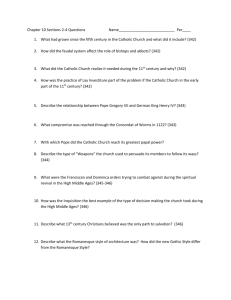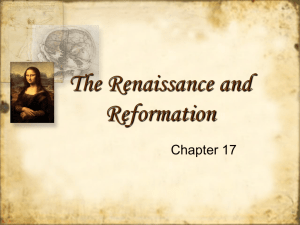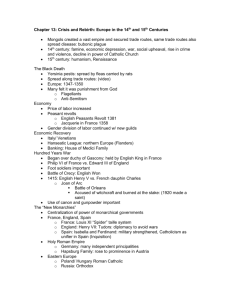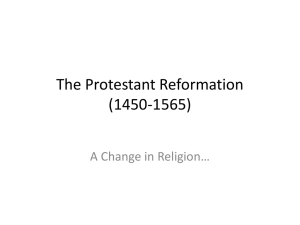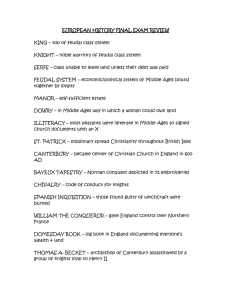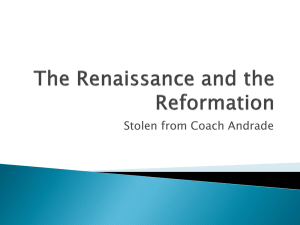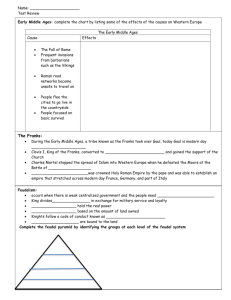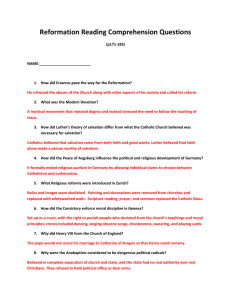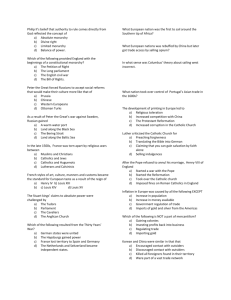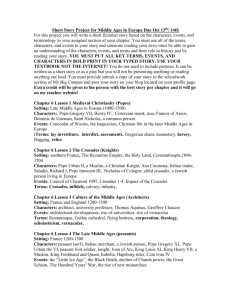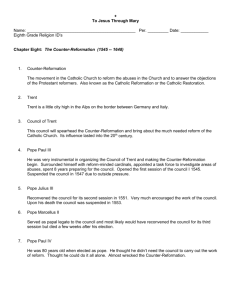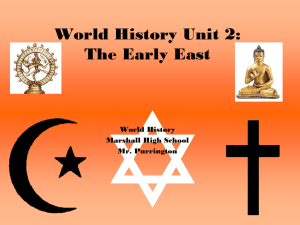Medieval Europe
advertisement
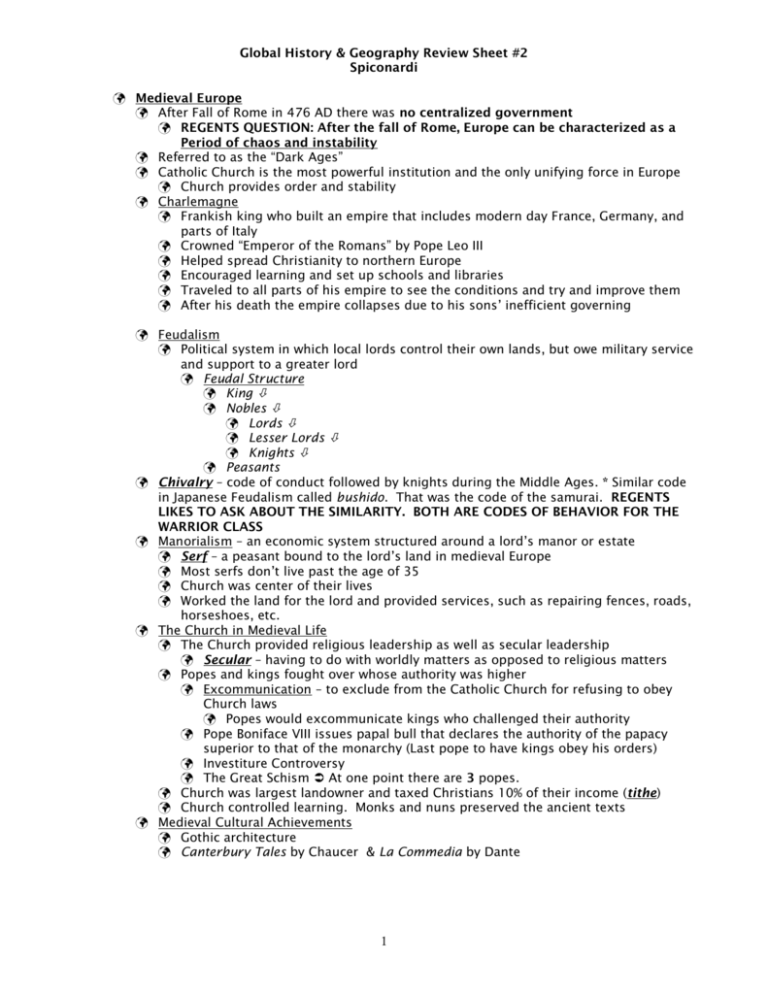
Global History & Geography Review Sheet #2 Spiconardi Medieval Europe After Fall of Rome in 476 AD there was no centralized government REGENTS QUESTION: After the fall of Rome, Europe can be characterized as a Period of chaos and instability Referred to as the “Dark Ages” Catholic Church is the most powerful institution and the only unifying force in Europe Church provides order and stability Charlemagne Frankish king who built an empire that includes modern day France, Germany, and parts of Italy Crowned “Emperor of the Romans” by Pope Leo III Helped spread Christianity to northern Europe Encouraged learning and set up schools and libraries Traveled to all parts of his empire to see the conditions and try and improve them After his death the empire collapses due to his sons’ inefficient governing Feudalism Political system in which local lords control their own lands, but owe military service and support to a greater lord Feudal Structure King Nobles Lords Lesser Lords Knights Peasants Chivalry – code of conduct followed by knights during the Middle Ages. * Similar code in Japanese Feudalism called bushido. That was the code of the samurai. REGENTS LIKES TO ASK ABOUT THE SIMILARITY. BOTH ARE CODES OF BEHAVIOR FOR THE WARRIOR CLASS Manorialism – an economic system structured around a lord’s manor or estate Serf – a peasant bound to the lord’s land in medieval Europe Most serfs don’t live past the age of 35 Church was center of their lives Worked the land for the lord and provided services, such as repairing fences, roads, horseshoes, etc. The Church in Medieval Life The Church provided religious leadership as well as secular leadership Secular – having to do with worldly matters as opposed to religious matters Popes and kings fought over whose authority was higher Excommunication – to exclude from the Catholic Church for refusing to obey Church laws Popes would excommunicate kings who challenged their authority Pope Boniface VIII issues papal bull that declares the authority of the papacy superior to that of the monarchy (Last pope to have kings obey his orders) Investiture Controversy The Great Schism At one point there are 3 popes. Church was largest landowner and taxed Christians 10% of their income (tithe) Church controlled learning. Monks and nuns preserved the ancient texts Medieval Cultural Achievements Gothic architecture Canterbury Tales by Chaucer & La Commedia by Dante 1 Global History & Geography Review Sheet #2 Spiconardi The Crusades The Schism (1054) – Catholic Church splits into the Roman Catholic Church (West) and the Orthodox Church (East/Byzantine) In 1093 the Byzantine Emperor Alexius asks Urban II for help against the Seljuk Turks Urban II agrees because he believes he can reunite the Church Reasons for the Crusades Pope believed his power would increase in Europe Christians believed their sins would be forgiven if they took back the Holy Land from the Muslims Nobles believed they could gain land in the Middle East Serfs hoped to escape feudal oppression Christians win The First Crusade, but lose the other crusades Impact of the Crusades Increase in trade Merchant class develops in Venice and other Italian city-states New goods brought to Europe (sugar, cotton, rice) Encouragement of Learning Muslims preserved Greco-Roman learning Europeans learn from Islamic advancements in math, science, and architecture Feudalism is weakened Needed money to finance Crusades, so lords charged rent Religious intolerance Limited Monarchy in England English people are upset with King John III after he is excommunicated in 1215 He fought many wars and lost quite a few Had high taxation Had to give up England to Pope in order to be readmitted to Catholic Church Magna Carta Nobles force King John to sign the Magna Carta, which placed limits on the king’s power King now had to get Parliament’s permission to raise taxes Trial by jury Establishes common law Common law Same laws are applicable to all people; no matter class, race, religion everyone goes by and are held to the same laws. This is different from Hammurabi’s Code The Bubonic Plague/Black Death Garbage Rats Fleas Humans Disease originated in China and came to Europe via trading ships Trade between East and West comes to a temporary stop 33% of European population dies Continues to weaken feudalism The Renaissance Humanism – intellectual movement at the heart of the Renaissance that focused on worldly subjects (human achievement/potential) rather than religious ones There is an emphasis on the individual Challenging of the “old ways” of thinking Return to Greek and Roman culture Renaissance begins in Northern Italy due to developing merchant class Merchants and wealthy patrons like the Medici pay artists like Michelangelo and Leonardo da Vinci to create artwork 2 Global History & Geography Review Sheet #2 Spiconardi Niccolo Machiavelli Writes The Prince, which encourages rulers and leaders to use any means necessary to achieve their goals Gutenberg’s Printing Press Books become more available Literacy rate increase Ideas and knowledge spread rapidly; access to new knowledge Reformation and Counter-Reformation Causes of the Reformation Renaissance thinking Monarchs wanting to break away from Church authority Problems in the Church Pope had become too powerful More concerned with politics than religion Indulgences – sale of the forgiveness of punishment for sins Martin Luther German monk who writes 95 Theses, which were 95 arguments against indulgences Beliefs Believed people could only reach Heaven through faith alone All teachings must come from the Bible Priest should be allowed to marry No ornate vestments for priests Luther is excommunicated by Leo X Luther is supported by northern European kings and princes Luther is NOT out to start a new faith, but his followers call themselves Lutherans and Protestants since the protested papal authority John Calvin Beliefs Could only gain salvation through faith Predestination – belief that God determined who was going to Heaven and Hell before the beginning of time; your destination in the afterlife was already determined by God Founds a theocracy in Switzerland Only could wear black, gray, and brown No fun, games, music King Henry VIII of England Wanted an annulment from the pope because his wife did not “give him a son” Pope refuses to grant annulment Henry VIII forms the Anglican Church of England and makes himself the head of the new church and gives himself a divorce Also beheads two of his wives for being “disloyal” 3 Global History & Geography Review Sheet #2 Spiconardi Counter Reformation Purpose was to strengthen the Catholic Church and stop spread of Protestantism Council of Trent Pope Paul III calls reform meeting in which the Catholic Church stands by its teachings Outlaws simony and limits indulgences Effects of the Reformation New Christian faiths and denominations emerge Catholic Church loses power Pope lost much of his power and authority Religion no longer unites Europe Religious wars between Charles V and German Protestant princes Hundred Years’ War Conflict between France and England Marks the end of feudal Europe Increase in nationalism Joan of Arc Middle Ages vs. Renaissance Middle Ages Renaissance Life centers around the Church Secularism Live your life to enter Heaven Humanism Art and music reflect religious Live life in the here and now values Revival of Greco-Roman art and architecture Gothic Architecture reintroduction of columns and realistic art 4

